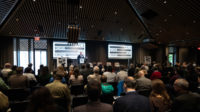On February 1, only a few months after the Brooklyn-based Bernheimer Architecture (BA) formed the first private-sector architecture union in the country, the Center for Architecture in New York hosted a panel discussion addressing ongoing issues surrounding unionization in the profession. At the sold-out “Unionization in Architecture” event organized by AIA New York’s Emerging New York Architects and Future of Practice committees, BA principal Andrew Bernheimer and project designer Kolby Forbes were joined in conversation by Andrew Daley, an architect and activist who serves as associate organizer with Architectural Workers United (AWU), and organizing veterans Jennifer Dorning of the American Federation of Labor and Congress of Industrial Organization (AFO-CIO) and New York Labor Council president Vincent Alvarez.
Panel moderator Andrea Lamberti, a partner at Rafael Viñoly Architects and AIANY’s 2022 president, kicked off the talk with a broad question for the group: why do people want to join unions? According to the Bureau of Labor Statistics, in 2022 alone, union membership increased by 273,000, the first membership growth in five years.
Dorning, who leads the Department for Professional Employees at AFL-CIO, explained that one reason for the recent spike in organizing is the public nature of recent campaigns, such as those at large corporations like Amazon: “Media coverage of organizing begets more organizing,” she said. This is true in the field of architecture, as in the original statement declaring SHoP Architects workers’ intent to organize in 2021, AWU cited the influence of unionization campaigns at Kickstarter, Starbucks, The New Yorker, and the New Museum, among others. Furthermore, the highly publicized campaign at the firm, though ultimately unsuccessful, set the stage for organizing efforts at other firms and ignited a broader conversation about labor issues in the field. Alvarez echoed the often-made, though no less accurate, observation that the economic toll of the pandemic magnified existing labor issues as workers across industries looked to the long-standing labor movement for help.
Forbes, a project designer who joined BA in 2021, corroborated Alvarez’s point, describing how over the pandemic, when work shifted from the office to remote, she realized the actual toll of long hours and inadequate pay, and how unsustainable her work-life balance had become. She spoke of a mentality shift among younger workers who realized that unions could be useful in more than just the worst-case scenarios: “They’re about ensuring protections,” she said. Daley, a former SHoP employee who is now a prominent voice in the architecture labor movement, noted that all architectural workers are “at-will” employees, meaning that they can be fired at any time without any reason, making them particularly vulnerable to economic fluctuations.
Bernheimer is also a full-time faculty member at the New School, where a contentious three-week strike in late 2022 was waged by adjunct faculty members over low wages and lack of benefits. (These workers comprise more than 90 percent of the university’s teaching staff.) At the Center for Architecture event, Bernheimer raised another issue that has been aired in the broader conversation concerning architectural work: that unsustainable labor practices start in architecture school. “Organizing and advocating for yourself shouldn’t start when you leave school,” he said.
Daley added: “We [as architects] are taught to devalue our time from the moment we start school.”
Two of Lamberti’s questions came from the committees behind the event, and though the New York City chapter of the AIA’s hosting of the event is significant given the silence on the part of the national organization on the topic, the questions themselves signaled the generational divide that has marked this most recent surge of the labor movement. The first question, “is the labor movement at large more beneficial to younger, early-career architectural workers?” received a firm “no” in response from Daley, with a lengthier explanation about the value of union density in the profession. The second question, “What kind of firms can benefit from unionization?” drew laughter from the audience, the majority of whom (as determined by a hand-raise later in the talk) were architectural workers rather than management. “All of them,” was Daley’s short answer.
Lamberti also asked Bernheimer and Forbes if they had noticed any tangible difference in the culture at the 22-person firm since management voluntarily recognized the union this fall. Kolby, who is one of sixteen on the negotiating team for the BA union as they hammer out the details of the contract, said that the dynamics between colleagues seemed more open: “We’re no longer in competition with each other,” she said, “because, with the protection of the union, we are no longer disposable.” Bernheimer, seemingly pushing back against the implicit narrative behind the failure to organize at SHoP, a considerably larger firm with 135 employees at the time talks fell apart, and BA's success—that a union can only advance with full-throated support from an empathetic management team—stressed that “unions are about reciprocal benefit.” For owners, he argued, unions can provide stability, structure, and longevity for firms, and can empower owners to ask for higher fees from clients. As of yet, he said, his relationships with clients haven't been impacted by the news and the firm’s project fees will not change until the bargaining process is complete.
One audience member, who identified herself as a firm owner, had a question for Bernheimer about the ability of architecture to “pay for itself.” She asked: “Can we afford to pay people fairly?”
“We have to,” responded Bernheimer. The fear of increased operating costs in a business that operates on already-slim margins has circulated among firm owners as the unionization movement has gathered steam. However, Daley added that there are numerous non-financial protections offered by unions that don’t drive up the cost of operating. Furthermore, he argued, restrictions on overtime gives owners an incentive to be smarter with their time to the benefit of the firm’s productivity as well as the well-being of its workers.
Much is yet to be seen as the BA union begins to negotiate the terms of a final contract in the coming months, and until more architecture firms currently organizing with AWU become public. Still, the issues raised by a younger generation of architects remain relevant as an economic downturn looms, and the strong showing at the Center for Architecture panel shows that leaders in the field are listening.
Listen to Andrew Daley and Danielle Tellez of Architectural Workers United discuss the push for unionization in architecture on the most recent episode of RECORD's DESIGN:ED podcast.






Post a comment to this article
Report Abusive Comment